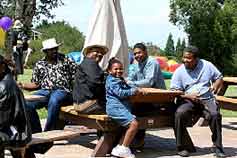

Thursday - June 15, 2006
SLAC Today is
available online at:
http://today.slac.stanford.edu
In this issue:
Juneteenth Celebration Tomorrow
Science Today: Dark Matter at High-Energy Colliders
Board of Trustees Committee Visits SLAC
Volunteers Needed for Commencement Tours
 |
 |
|
Thursday - June 15, 2006 |

The 2005 Juneteenth Celebration Juneteenth Celebration TomorrowJuneteenth, a celebration of the end of slavery, comes to SLAC this Friday. Everyone is invited to join in the carnival atmosphere, listen to great music and eat traditional Southern food from 11:30 a.m. until 3:30 p.m. on the lawn west of the Research Office Building (ROB). "Our goal was to make it more of a SLAC-wide event rather than just including the African-American community," said Juneteenth Committee Member Rod Reape. "We are pleased to have strong support from Jonathan Dorfan." This year's event will include a DJ, dancers, and food ranging from barbeque ribs to sweet potato pie. Information on America's black history will also be available. "The committee really went all out this year," said Reape. "Our goal was to sell 300 tickets and we believe we've already reached that goal." Tickets will also be available for sale at the event. |
||||||||||||||||||||||||||
|
|
||||||||||||||||||||||||||
 Dark Matter at High-Energy Colliders
To do this, it is first necessary to create dark matter in high-energy particle accelerators like the Large Hadron Collider (LHC) and the proposed International Linear Collider (ILC). It is then necessary to detect the dark matter particles in the galaxy, rather than in the lab. This can be done directly with sensitive detectors deep underground, such as the Cryogenic Dark Matter Search (CDMS) project based at Stanford. Dark matter in the galaxy can also annihilate, producing high energy gamma rays detectable by the Gamma-ray Large Area Space Telescope (GLAST) satellite, to be launched in 2007. Baltz and collaborators have identified the astrophysical and collider measurements that would be required to understand the cosmic dark matter. Precise measurements likely to come from the ILC are a crucial part of the program. |
Board of Trustees Committee Visits SLAC
The Committee on Academic Policy, Planning and Management of the Stanford Board of Trustees visited SLAC yesterday. After introductions by Jonathan Dorfan, they visited the Stanford Synchrotron Radiation Laboratory (SSRL) and the Overlook, where they viewed the future site of the Linac Coherent Light Source (LCLS). Volunteers Needed for Commencement ToursThis Saturday, more than 500 Stanford commencement visitors will tour SLAC. The tour office needs volunteers to ensure the visitors don't stray into restricted areas. "You don't have to say anything, you just have to go along for the ride in an air-conditioned bus and help the tour guides keep visitors within marked areas in the linac," said Tour Coordinator Maura Chatwell. "I would really appreciate if anyone can help. This is the biggest event of the year for our tour program." Tours begin at 1:00 and 2:30 p.m. on Saturday, June 17. To volunteer, please contact Maura Chatwell at maura@slac.stanford.edu or extension 4931. |
Events (see all | submit)
Access (see all)Announcements
|
||||||||||||||||||||||||
| | ||||||||||||||||||||||||||
What's Cookin' at the Linear Cafee (see weekly menu)
|
||||||||||||||||||||||||||
|
|
||||||||||||||||||||||||||
 <%
Response.AddHeader "Last-modified", getArticleDate()
'Response.AddHeader "Last-modified","Mon, 01 Sep 1997 01:03:33 GMT"
'Monday, December 06, 2010
%>
<%
Response.AddHeader "Last-modified", getArticleDate()
'Response.AddHeader "Last-modified","Mon, 01 Sep 1997 01:03:33 GMT"
'Monday, December 06, 2010
%>View online at http://today.slac.stanford.edu/. |
||||||||||||||||||||||||||